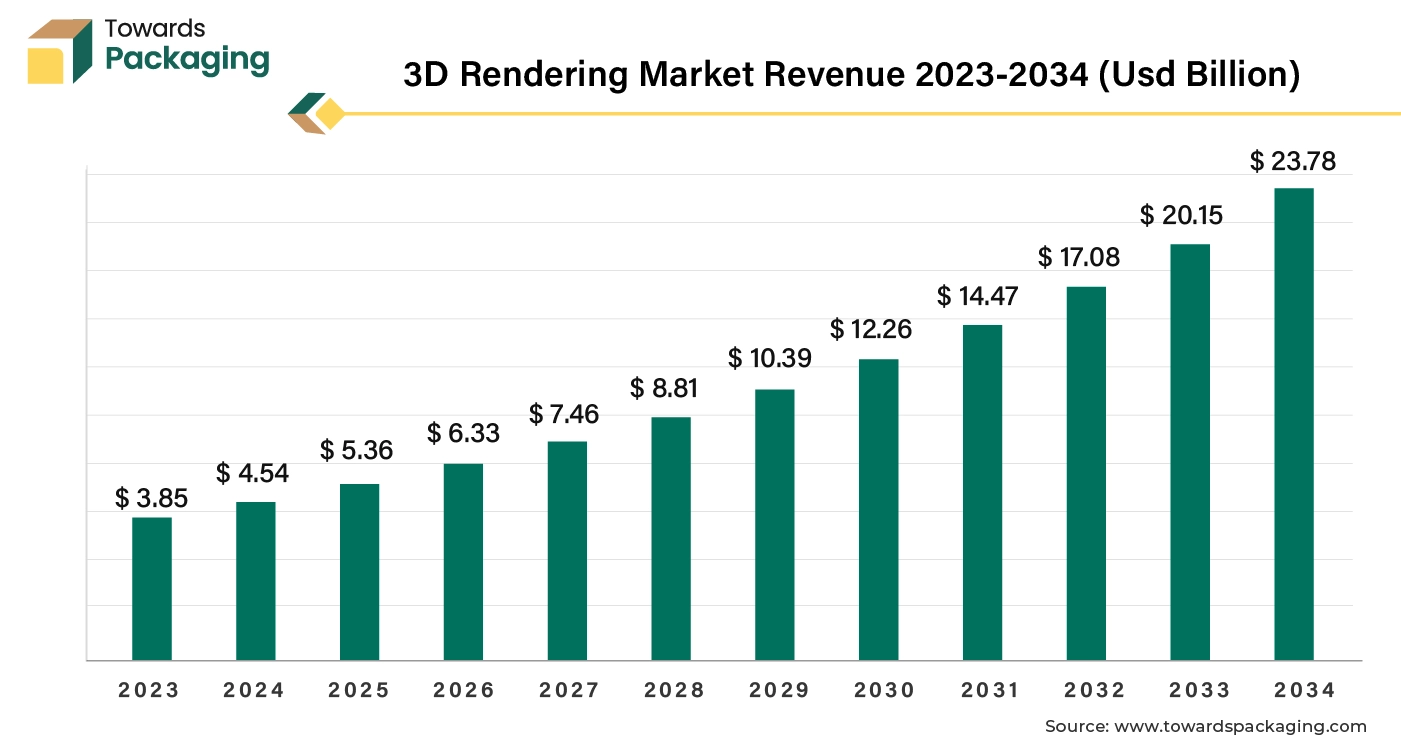The global 3D rendering market was valued at approximately USD 3.85 billion in 2023 and is anticipated to grow to around USD 23.78 billion by 2034, with a compound annual growth rate (CAGR) of 18% during the forecast period from 2024 to 2034.

Download Statistical Data: https://www.towardspackaging.com/download-statistics/5267
The rising interest in VR and AR applications necessitates advanced 3D rendering techniques. The key players operating in the market are focused on adopting inorganic growth strategies like acquisition and merger to develop 3D rendering which is estimated to drive the global 3D Rendering market over the forecast period.
Major Key Insights of the 3D Rendering Market
- North America dominated the 3D rendering market in 2023.
- Asia Pacific is expected to grow at a significant rate in the market during the forecast period.
- By component, the software segment dominated the market with the largest share in 2023.
- By organization size, large enterprises segment is expected to grow at significant rate during the forecast period.
- By operating system, windows segment led the global 3D rendering market.
- By application, visualisation and simulation segment dominated the market globally.
- By end use, the architecture, engineering & construction segment dominated the 3D rendering market in 2023.
3D Rendering Market: Generating Visual Images
The process of using computer graphics to create a two-dimensional image from a three-dimensional model is known as 3D rendering. This technique is widely used in various fields, including animation, architecture, film, video games, and product design. 3D Rendering is done utilizing different techniques ray tracing, global illumination, and rasterization.
3D Rendering is utilized in various sectors such as architecture, product design and entertainment among others. Architects use rendering to visualize buildings and spaces before construction, providing clients with realistic previews. Companies use rendering to showcase products in marketing materials and design reviews, allowing for adjustments before physical production. In films and video games, rendering is essential for creating immersive worlds and characters.
3D rendering is a complex, multi-step process that transforms digital models into visually stunning images. It combines artistry with technology, enabling creators to visualize and communicate ideas in various industries effectively. As technology advances, rendering techniques continue to evolve, pushing the boundaries of realism and creativity in digital media.
7 Key Factors Driving 3D Rendering Market Growth
- The key players operating in the market are focused on geographic expansion and launching their brand in other countries which is expected to drive the growth of the 3D Rendering market in the near future.
- Increasing focus on cost reduction and production efficiency can drive the specialty market growth further.
- Emerging markets and trends for 3D rendering technology it is expected to drive the growth of the global 3D Rendering market over the forecast period.
- Increasing regulatory support is estimated to drive the growth of the market over the forecast period.
- Increasing in adoption of the advanced technology for the production of 2D images using 3D rendering technology is estimated to drive the growth of the global 3D Rendering market in the near future.
- Increasing trend for customized products has driven the demand of 3D rendering software.
- Outsourcing of 3D rendering services fuelling growth of the 3D rendering market.
How Can AI Improve the 3D Rendering Industry?
AI algorithms can optimize rendering processes, reducing time needed for complex scenes. Techniques like denoising can accelerate the final output by cleaning up noise in real-time. AI-driven upscaling can enhance low-resolution images or models to higher resolutions without significant loss of quality, saving time and resources. AI can analyze user preferences and automatically adjust rendering settings or styles to match specific needs or trends.
AI can automate repetitive tasks such as UV mapping, texture generation, and lighting adjustments, allowing artists to focus on more creative aspects. Machine learning models can generate high-quality textures, realistic materials, and improved lighting effects, elevating the overall realism of renders. AI can assist in procedural content generation, creating complex environments or assets dynamically based on parameters set by artists.
With AI, real-time rendering becomes more feasible, enabling interactive experiences in gaming and virtual reality. AI can analyze completed projects and provide insights or suggestions for improvement, fostering a continuous learning environment. By leveraging these capabilities, the 3D rendering industry can achieve higher quality outputs faster while enhancing creative possibilities.
Buy Premium Global Insight: https://www.towardspackaging.com/price/5267
Get the latest insights on packaging industry segmentation with our Annual Membership – https://www.towardspackaging.com/get-an-annual-membership
If you have any questions, please feel free to contact us at sales@towardspackaging.com
About Us
Towards Packaging is a leading global consulting firm specializing in providing comprehensive and strategic research solutions. With a highly skilled and experienced consultant team, we offer a wide range of services designed to empower businesses with valuable insights and actionable recommendations. We stay abreast of the latest industry trends and emerging markets to provide our clients with an unrivalled understanding of their respective sectors. We adhere to rigorous research methodologies, combining primary and secondary research to ensure accuracy and reliability. Our data-driven approach and advanced analytics enable us to unearth actionable insights and make informed recommendations. We are committed to delivering excellence in all our endeavours. Our dedication to quality and continuous improvement has earned us the trust and loyalty of clients worldwide.
Browse our Brand-New Journal: